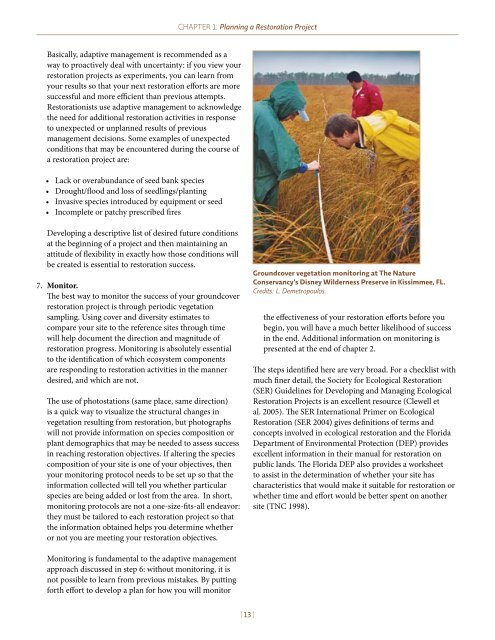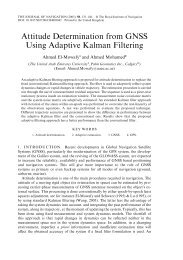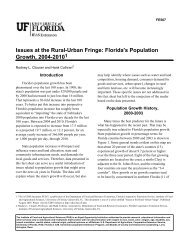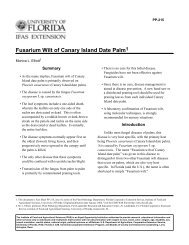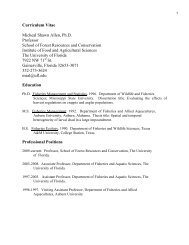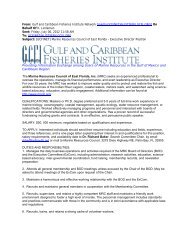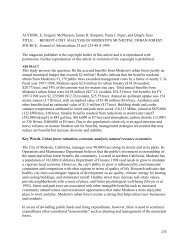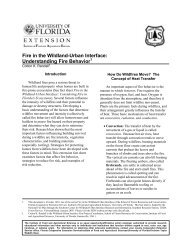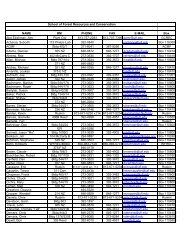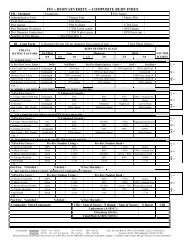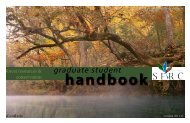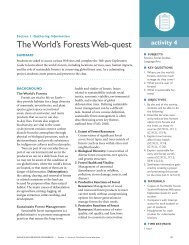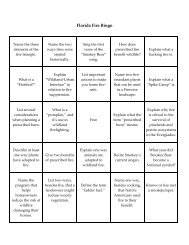Chapter 1: Plann<strong>in</strong>g a <strong>Restoration</strong> Project<strong>the</strong> budget required for <strong>in</strong>dividual restoration projectsvaries widely accord<strong>in</strong>g to <strong>the</strong> activities required. Forexample, projects that <strong>in</strong>volve herbicide applications,and/or seed<strong>in</strong>g and plant<strong>in</strong>g will cost more than thosethat simply <strong>in</strong>volve tree harvest, th<strong>in</strong>n<strong>in</strong>g and/or burn<strong>in</strong>g.Many restorationists suggest that a m<strong>in</strong>imum <strong>of</strong> 5 years<strong>of</strong> fund<strong>in</strong>g be set aside for any project to have a bufferaga<strong>in</strong>st set-backs and delays. O<strong>the</strong>rs suggest that fund<strong>in</strong>gbe secured for a much longer timeframe. Some types<strong>of</strong> management, such as prescribed fire and removal <strong>of</strong><strong>in</strong>vasive exotic species, will need to be implemented on<strong>the</strong> restoration site as long as <strong>the</strong> site exists, requir<strong>in</strong>g an<strong>in</strong>vestment <strong>of</strong> time and funds <strong>in</strong> perpetuity. <strong>Restoration</strong>is a long-term commitment that should not be <strong>in</strong>itiatedif future availability <strong>of</strong> f<strong>in</strong>ancial resources is highlyuncerta<strong>in</strong>.Prior to <strong>the</strong> <strong>in</strong>itiation <strong>of</strong> any restoration activities, carefulconsideration should be given to <strong>the</strong> identification <strong>of</strong> <strong>the</strong>follow<strong>in</strong>g items:• Fund<strong>in</strong>g sources• Labor availability• Equipment• Biotic resourcesIf <strong>the</strong> availability <strong>of</strong> any <strong>of</strong> <strong>the</strong>se resources is limited oruncerta<strong>in</strong>, your proposed restoration project may not befeasible.4. Identify <strong>the</strong> reference community for your site.The goal <strong>of</strong> a restoration project would ideally be torestore <strong>the</strong> previously <strong>in</strong>tact ecosystem that has beenlost from that site. Unfortunately, this <strong>in</strong>formation is<strong>of</strong>ten unavailable for sites that have been impacted forlong periods <strong>of</strong> time, and <strong>in</strong> o<strong>the</strong>r cases <strong>the</strong> <strong>in</strong>formationthat is available is not sufficient to fully characterize <strong>the</strong>restoration goals. Egan and Howell (2001) have created auseful key to identify reference <strong>in</strong>formation that can beused to determ<strong>in</strong>e <strong>the</strong> potential composition, structureand function for a restoration site <strong>in</strong> situations where that<strong>in</strong>formation is miss<strong>in</strong>g. In short, when historical data ismiss<strong>in</strong>g and <strong>the</strong>re is no <strong>in</strong>tact habitat on <strong>the</strong> restorationsite, <strong>of</strong>f-site locations, known as “reference sites”, thatmatch <strong>the</strong> conditions and geography <strong>of</strong> <strong>the</strong> restorationsite are used to ga<strong>in</strong> basel<strong>in</strong>e data. A complete description<strong>of</strong> this methodology is given <strong>in</strong> <strong>the</strong> section <strong>of</strong> this manualentitled “Select<strong>in</strong>g Reference Sites” (see Chapter 2).5. Determ<strong>in</strong>e which restoration activities are necessary toreach <strong>the</strong> restoration goals you set for your site.<strong>Restoration</strong>ists should conduct site assessments atreference sites and at <strong>the</strong> sites to be restored, and <strong>the</strong>ncompare <strong>the</strong> ecological attributes between <strong>the</strong> sites<strong>in</strong> order to prioritize which attributes need to be andcan be addressed. Dur<strong>in</strong>g this process, considerationshould be given to previous research <strong>in</strong> <strong>the</strong> communitybe<strong>in</strong>g restored. The activities required for groundcoverrestoration can be determ<strong>in</strong>ed us<strong>in</strong>g <strong>in</strong>formationavailable <strong>in</strong> this manual, from <strong>the</strong> literature, and bycontact<strong>in</strong>g <strong>the</strong> people who are active <strong>in</strong> your specifichabitat or geographic area. Specific restoration activitiesthat are discussed <strong>in</strong> this manual are:• Mechanical site preparation• Chemical site preparation• Cutt<strong>in</strong>g/th<strong>in</strong>n<strong>in</strong>g canopy or midstory trees• Prescribed fire• Outplant<strong>in</strong>g• Direct seed<strong>in</strong>gEach <strong>of</strong> <strong>the</strong>se techniques can be used alone or <strong>in</strong>comb<strong>in</strong>ation with o<strong>the</strong>rs.6. Develop a detailed project schedule and be prepared tochange it.Many <strong>of</strong> <strong>the</strong> activities required for groundcoverrestoration need to be timed appropriately. Therefore,plann<strong>in</strong>g out a detailed schedule <strong>of</strong> activities that will beneeded each season is an essential <strong>in</strong>gredient to success.However, chaos is real. Be aware that <strong>the</strong> climate, <strong>the</strong>contractors, and <strong>the</strong> equipment are not under yourcomplete control. By <strong>the</strong> time you complete a restorationproject, <strong>the</strong>re will likely be many activities that youneeded to do that you didn’t plan for <strong>in</strong>itially. The abilityto change course <strong>in</strong> response to unplanned results is part<strong>of</strong> adaptive management. Adaptive management is anapproach to resource management which emphasizesmonitor<strong>in</strong>g <strong>the</strong> effects <strong>of</strong> management actions with <strong>the</strong><strong>in</strong>tention <strong>of</strong> chang<strong>in</strong>g management tactics if it becomesapparent that actions are not meet<strong>in</strong>g <strong>the</strong> orig<strong>in</strong>alobjectives. In <strong>the</strong> realm <strong>of</strong> restoration, this means that<strong>the</strong> effects <strong>of</strong> restoration activities are monitored, anddifferent actions are implemented if it becomes apparentthat site conditions are not chang<strong>in</strong>g along <strong>the</strong> trajectorydesired. This approach <strong>in</strong>creases efficiency and also<strong>in</strong>creases chances <strong>of</strong> success <strong>in</strong> <strong>the</strong> long-term.In practice, adaptive management <strong>in</strong>volves “treat<strong>in</strong>gmanagement and policy decisions that result <strong>in</strong>management as large experiments that test predictionsand assumptions <strong>in</strong> management plans, and <strong>the</strong>n us<strong>in</strong>g<strong>the</strong> results to revise and improve <strong>the</strong> plans.” (TNC 1998).| 12 |
Chapter 1: Plann<strong>in</strong>g a <strong>Restoration</strong> ProjectBasically, adaptive management is recommended as away to proactively deal with uncerta<strong>in</strong>ty: if you view yourrestoration projects as experiments, you can learn fromyour results so that your next restoration efforts are moresuccessful and more efficient than previous attempts.<strong>Restoration</strong>ists use adaptive management to acknowledge<strong>the</strong> need for additional restoration activities <strong>in</strong> responseto unexpected or unplanned results <strong>of</strong> previousmanagement decisions. Some examples <strong>of</strong> unexpectedconditions that may be encountered dur<strong>in</strong>g <strong>the</strong> course <strong>of</strong>a restoration project are:• Lack or overabundance <strong>of</strong> seed bank species• Drought/flood and loss <strong>of</strong> seedl<strong>in</strong>gs/plant<strong>in</strong>g• Invasive species <strong>in</strong>troduced by equipment or seed• Incomplete or patchy prescribed firesDevelop<strong>in</strong>g a descriptive list <strong>of</strong> desired future conditionsat <strong>the</strong> beg<strong>in</strong>n<strong>in</strong>g <strong>of</strong> a project and <strong>the</strong>n ma<strong>in</strong>ta<strong>in</strong><strong>in</strong>g anattitude <strong>of</strong> flexibility <strong>in</strong> exactly how those conditions willbe created is essential to restoration success.7. Monitor.The best way to monitor <strong>the</strong> success <strong>of</strong> your groundcoverrestoration project is through periodic vegetationsampl<strong>in</strong>g. Us<strong>in</strong>g cover and diversity estimates tocompare your site to <strong>the</strong> reference sites through timewill help document <strong>the</strong> direction and magnitude <strong>of</strong>restoration progress. Monitor<strong>in</strong>g is absolutely essentialto <strong>the</strong> identification <strong>of</strong> which ecosystem componentsare respond<strong>in</strong>g to restoration activities <strong>in</strong> <strong>the</strong> mannerdesired, and which are not.The use <strong>of</strong> photostations (same place, same direction)is a quick way to visualize <strong>the</strong> structural changes <strong>in</strong>vegetation result<strong>in</strong>g from restoration, but photographswill not provide <strong>in</strong>formation on species composition orplant demographics that may be needed to assess success<strong>in</strong> reach<strong>in</strong>g restoration objectives. If alter<strong>in</strong>g <strong>the</strong> speciescomposition <strong>of</strong> your site is one <strong>of</strong> your objectives, <strong>the</strong>nyour monitor<strong>in</strong>g protocol needs to be set up so that <strong>the</strong><strong>in</strong>formation collected will tell you whe<strong>the</strong>r particularspecies are be<strong>in</strong>g added or lost from <strong>the</strong> area. In short,monitor<strong>in</strong>g protocols are not a one-size-fits-all endeavor:<strong>the</strong>y must be tailored to each restoration project so that<strong>the</strong> <strong>in</strong>formation obta<strong>in</strong>ed helps you determ<strong>in</strong>e whe<strong>the</strong>ror not you are meet<strong>in</strong>g your restoration objectives.<strong>Groundcover</strong> vegetation monitor<strong>in</strong>g at The NatureConservancy’s Disney Wilderness Preserve <strong>in</strong> Kissimmee, FL.Credits: L. Demetropoulos.<strong>the</strong> effectiveness <strong>of</strong> your restoration efforts before youbeg<strong>in</strong>, you will have a much better likelihood <strong>of</strong> success<strong>in</strong> <strong>the</strong> end. Additional <strong>in</strong>formation on monitor<strong>in</strong>g ispresented at <strong>the</strong> end <strong>of</strong> chapter 2.The steps identified here are very broad. For a checklist withmuch f<strong>in</strong>er detail, <strong>the</strong> Society for Ecological <strong>Restoration</strong>(SER) Guidel<strong>in</strong>es for Develop<strong>in</strong>g and Manag<strong>in</strong>g Ecological<strong>Restoration</strong> Projects is an excellent resource (Clewell etal. 2005). The SER International Primer on Ecological<strong>Restoration</strong> (SER 2004) gives def<strong>in</strong>itions <strong>of</strong> terms andconcepts <strong>in</strong>volved <strong>in</strong> ecological restoration and <strong>the</strong> FloridaDepartment <strong>of</strong> Environmental Protection (DEP) providesexcellent <strong>in</strong>formation <strong>in</strong> <strong>the</strong>ir manual for restoration onpublic lands. The Florida DEP also provides a worksheetto assist <strong>in</strong> <strong>the</strong> determ<strong>in</strong>ation <strong>of</strong> whe<strong>the</strong>r your site hascharacteristics that would make it suitable for restoration orwhe<strong>the</strong>r time and effort would be better spent on ano<strong>the</strong>rsite (TNC 1998).Monitor<strong>in</strong>g is fundamental to <strong>the</strong> adaptive managementapproach discussed <strong>in</strong> step 6: without monitor<strong>in</strong>g, it isnot possible to learn from previous mistakes. By putt<strong>in</strong>gforth effort to develop a plan for how you will monitor| 13 |


